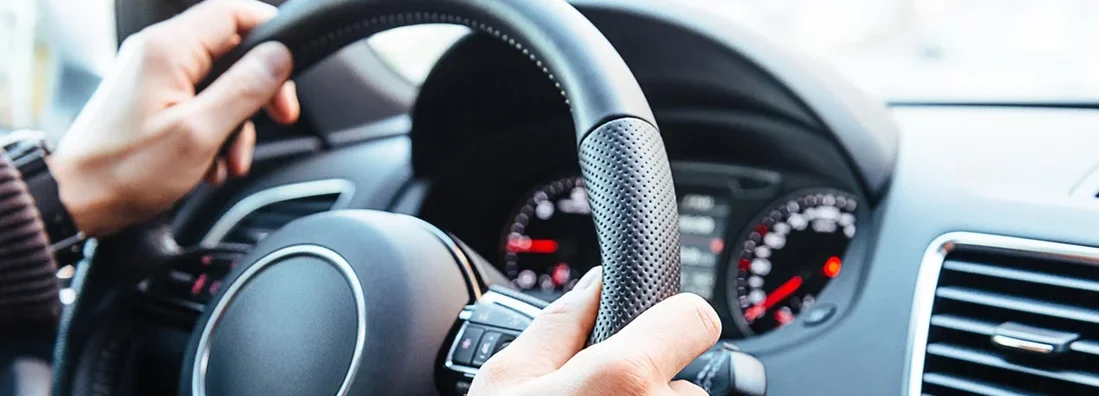What Is Defensive Driving? Techniques & Tips for Becoming a Better Defensive Driver

Jeff Green has held a variety of sales and management roles at life insurance companies, Wall street firms, and distribution organizations over his 40-year career. He was previously Finra 7,24,66 registered and held life insurance licenses in multiple states. He is a graduate of Stony Brook University.

As all drivers should know, getting behind the wheel of a car doesn't come without risks. However, understanding the basic concepts behind defensive driving is a great start in reducing these risks. Learning what it means to be a defensive driver and putting some recommended safety practices in place while you're on the road can go a long way.
Of course, you'll also need to make sure your vehicle is protected by the right car insurance before you can legally hit the road. An independent insurance agent can help you get matched to the right coverage, fast. But first, here's a breakdown of defensive driving and 20 tips and techniques for you to become a better defensive driver.
What Is Defensive Driving?
Having a firm grasp on the meaning of defensive driving can help keep drivers safe. So, what does defensive driving mean? The meaning of defensive driving is a type of driving behavior that includes responding safely to other drivers on the road, pedestrians, weather changes, and other potential hazards.
Keep this defensive driving definition in mind before you hit the road next time. Being alert and ready to respond safely to hazards on and around the road can seriously help reduce your risk when you drive.
Benefits of Defensive Driving
So, what exactly is a defensive driver, and what is driving defensively? A defensive driver consistently applies safe driving behaviors and techniques to help reduce their risk of accidents and other mishaps.
Defensive drivers remain on alert and ready to anticipate changes to road and weather conditions and always keep an eye out for other drivers and pedestrians on the road. The benefits of understanding defensive driving and what being a defensive driver is include not only reducing your risk of accidents and keeping you safe, but also helping you avoid traffic violations like tickets and in turn, saving money on your car insurance.
Most states offer defensive driving classes. Some defensive driving classes can help you earn discounts on car insurance. But even without taking a course, remaining accident-free and keeping a clean driving record can almost certainly help reduce the cost of your car insurance.
20 Tips & Techniques for Becoming a Defensive Driver
How does one become a good defensive driver? There are many simple tips and techniques you can learn and keep in your arsenal while on the road.
Shifting certain behaviors and your mindset while driving can help you become a better defensive driver. To help you get started, we've put together a list of 20 tips and techniques to help you become a more defensive driver.
1) Focus on the task at hand
Defensive driving is all about being focused on the task at hand, which is driving safely. When you're behind the wheel, the main focus must always be what's going on on the road.
Keep the radio volume low, and don't let passengers distract you. A defensive driver is always assessing their surroundings for potential hazards and keeping their attention on weather and road conditions to monitor any changes.
2) Expect other drivers to make mistakes
Part of being a defensive driver is not trusting that other drivers aren't distracted or know how to drive defensively. When coming to an intersection, always watch other drivers to make sure they actually come to a complete stop when they're supposed to before you proceed.
Keep an eye on the vehicles around you in case they suddenly change lanes, even without signaling. Also, expect that some drivers on the road may not be from the area and are unfamiliar with local traffic patterns.
3) Slow down
Part of being a defensive driver is driving at a safe speed. Defensive driving means always being aware of the current speed limit and following these laws.
Teen drivers are statistically the most likely to engage in speeding behaviors on the road, which increases their risk of accidents exponentially. Driving at or below the legal speed limit allows drivers more time to respond to changes or potential hazards and avoid accidents.
4) Take advantage of safety devices
Safety features can help with defensive driving. Keep seat belts fastened at all times, and always ensure airbags are in working order.
Some vehicles offer other safety features that benefit defensive drivers, such as blind-spot monitors and lane assists. Many modern vehicles make a beeping sound if you attempt to back up or change lanes when a car or other object is in the way.
5) Always, always, always buckle up
Some of the saddest and most disturbing driving statistics show how many deaths could be prevented by simply wearing a seat belt. Proper seat belt use is a critical part of being a defensive driver. In one recent year, a reported 37,000 people were killed in traffic accidents, but 2,549 of these lives could've been saved if they'd only been wearing a seat belt at the time of the collision.
The National Safety Council reports that seat belts reduce your risk of injury in a crash by 50%. In another recent year, seat belts saved nearly 15,000 lives.
True defensive drivers make it a habit to buckle their seat belts right away when they get behind the wheel. Another part of defensive driving is not putting the vehicle into motion until you're sure all passengers are properly buckled.
6) When in doubt, yield
Defensive drivers know to yield in uncertain situations. If you're unsure of how to proceed in an intersection, or a traffic sign is missing or has been hit and is not clearly visible, practice the defensive driving technique of yielding to uncertainty. Once you've determined it's safe to continue, do so.
7) Stop on red
The leading cause of intersection collisions is running a red light. Sometimes, this happens due to a lack of attention to the road, while other times, it's due to the glare from the setting sun.
But sadly, sometimes it's because the driver was in a hurry. The best defensive driving practice is to slow down before each intersection and evaluate the situation. Never race the yellow light.
8) Use your blinkers
Another part of being a defensive driver is using turn signals appropriately. When you're about to change lanes or make a turn, always turn your blinker on early enough to signal to other drivers what you're planning to do.
Defensive driving means putting on a turn signal at least 100 feet in advance of the turn you'll make. If changing lanes, put on your blinker for at least 5 seconds before you make the move.
9) Let speeders pass
An effective part of a defensive driving strategy is to avoid conflict in the first place. Defensive drivers know to let speeders, or someone who's driving over the speed limit, pass them.
Don't feed into another driver's road rage by increasing your pace to interact with someone who's clearly in more of a hurry than you are. Prioritize your safety, the safety of your passengers, and the safety of others on the road at all times above winning an arbitrary speed battle on the road.
10) Keep a safe following distance
Another key part of being a defensive driver is maintaining a safe distance between vehicles and not tailgating. Once again, statistics show that teen drivers can be the most guilty of tailgating behaviors that greatly increase the risk of accidents.
The National Safety Commission reports that 40% of annual traffic accidents are rear-end collisions. Many of these accidents can be avoided by maintaining a safe driving distance and practicing defensive driving behaviors.
11) Monitor your blind spots and stay out of others' blind spots
A key part of being a defensive driver is understanding your own blind spots and staying out of other drivers' blind spots. While new cars come with safety features like blind spot detection, it doesn't guarantee that other vehicles around you are also equipped with this feature.
Defensive driving means being aware of your personal vehicle's blind spots before you hit the road and staying on alert for whether you're in the blind spot of any drivers around you at all times.
12) Don't drive drunk, buzzed, or high
A real defensive driver never drives while under the influence of any substances or medication with drowsy side effect warnings. If you're going out, keep in mind that the average drinker can only metabolize one drink per hour, which equates to 12 ounces of beer, five ounces of wine, or 1.5 ounces of distilled spirits.
Plan ahead for a designated driver if you'll be consuming liquor or other substances. Defensive driving means planning ahead for safe transportation any time indulging is involved.
13) Adjust for rain
Another key part of being a defensive driver is knowing how to drive in all types of weather conditions, including rain. Defensive driving also means knowing when and how to pull over to wait out severe weather.
Braking times increase in heavy downpours or the first 30 minutes of a heavy rain storm. Stay on high alert during these times, keep extra distance between your vehicle and those around you, turn on your hazards if necessary, and slow down to avoid skidding.
14) Prepare for snowy weather
Defensive drivers understand what it means to drive safely in the snow. Part of a good defensive driving strategy also includes making sure your car is ready for inclement weather in the winter.
Having snow tires or newer all-weather tires is essential before this season hits. Make sure to practice driving safely in snow and ice in parking lots before you try it on a busy roadway.
15) Inflate tires appropriately and change them when they are worn
Defensive drivers always ensure their tires have the correct amount of air in them and that the treads aren't worn down or bald. Part of a good defensive driving strategy involves checking your tire pressure on a routine basis. Don't hit the road if you have too low or high tire pressure or tires without sufficient tread on them. Change your tires as necessary.
Be sure to educate teen drivers about tire safety as well. Any teen drivers in your household aren't necessarily learning all the tips necessary to become a defensive driver in driver's ed. Part of your responsibility as a good defensive driver is to teach teen drivers to do the same.
16) Use headlights wisely
Knowing when to use your headlights, including fog lights and high beams, is another key part of being a defensive driver. In some states, it's required to use your headlights at any time of day when driving through tunnels, in rain, or through road construction areas.
If in doubt, turn your headlights on ahead of time. Make sure not to use high beams unless you're a safe distance away from other vehicles to avoid blinding those drivers.
17) Maintain your vehicle
Regular oil changes and fluid checks can save you from surprise breakdowns on the road. If your car becomes disabled on a busy highway or interstate, the National Safety Council recommends you try to pull over in the breakdown lane, if possible. Remember to use your turn signals and watch for fast-moving cars. If you have parked a comfortable distance from traffic, lock the doors and wait for help.
If you're close to traffic, exit the vehicle and find a safe place to stand, away from the side and rear of the car. If you cannot reach the breakdown lane and your car is stopped in traffic, leave the vehicle as soon as it's safe to do so and wait for help in a secure location on the side of the road.
18) Respond safely to tailgaters
Defensive drivers also know how to respond safely to tailgaters. Tailgating greatly increases the risk of being involved in a rear-end collision, and many of these accidents can be avoided with defensive driving behaviors.
If you're on a multi-lane road, move over into a right-hand lane to allow the tailgater to pass. If you're driving on a single-lane road, you can try to find a well-lit parking lot to pull into to allow the tailgater to pass by.
19) Keep a steady pace
Part of being a defensive driver means keeping a steady pace in your own vehicle. Maintaining a steady speed close to the legal speed limit allows for a smooth flow of traffic and greatly decreases the risk of accidents around you.
Defensive driving means not speeding but also moving quickly and efficiently enough not to cause unnecessary and potentially dangerous slowdowns in traffic.
20) Look far ahead of your vehicle
Looking ahead and being alert for possible problems like highway debris or erratic drivers is part of being a good defensive driver. Don't just watch the vehicle in front of you, but stay on alert and look at least a few car-lengths ahead of you for potential upcoming hazards.
Defensive driving means being able to anticipate possible problems ahead of you in enough time to be able to react appropriately and safely. Now, you'll have all the answers the next time one of your passengers asks, "What does it mean to drive defensively?"
Keep Yourself Safe and Protected
There are several defensive driving classes available online and in your area where you can learn more about how to be a safe driver. Defensive driving classes make a great gift for a young family member, or you can use them as a preventive exercise for yourself so you can pick up even more car safety tips.
Above all else, make sure you're covered with an affordable car insurance policy. Talk to a local independent insurance agent for help finding a great policy at a competitive price.
Frequently Asked Questions about Defensive Driving
Defensive driving means following safe practices on the road to be on alert for potential hazards. Defensive drivers give themselves plenty of time to safely and appropriately respond to these hazards, including changes in weather or road conditions, unsafe drivers around them, and traffic patterns.
An example of defensive driving is responding safely to tailgaters. If someone is tailgating you, a defensive driving practice would be to move into a right-hand lane when it's safe to do so and allow the tailgater to pass. However, if you're driving on a single-lane road, you can pull off at the nearest well-lit parking lot or area to allow the tailgater to pass.
The main principles of defensive driving are to always be on alert for potential hazards on the road and allow yourself plenty of time to respond to them safely. Defensive drivers minimize distractions as much as possible to keep their focus on the road. A key defensive driving habit means leaving plenty of space between your vehicle and others and driving within legal speed limits at all times to greatly reduce your risk of accidents.
Slow down on the road and be on high alert for your surroundings at all times to become a better defensive driver. Make sure you always have plenty of time to appropriately respond to changes in weather or road conditions. Becoming a better defensive driver can be easy when you follow the 20 tips we listed above.
Yes, being a defensive driver can help drastically reduce the cost of car insurance. Maintaining a clean driving record with no traffic violations or accidents can reduce car insurance premiums, as can enrolling in a program that monitors your driving behaviors and practicing defensive driving habits.
https://injuryfacts.nsc.org/motor-vehicle/motor-vehicle-safety-issues/speeding/
https://www.nhtsa.gov/risky-driving/seat-belts
https://www.foxbusiness.com/features/half-of-drivers-dont-use-turn-signals
https://www.nhtsa.gov/risky-driving/drunk-driving
https://www.progressive.com/answers/what-is-defensive-driving/
https://www.safemotorist.com/articles/defensive-driving/
https://www.valuepenguin.com/car-insurance-policy-number#:~:text=Frequently%20asked%20questions
https://www.bankrate.com/insurance/car/seat-belt-statistics/
